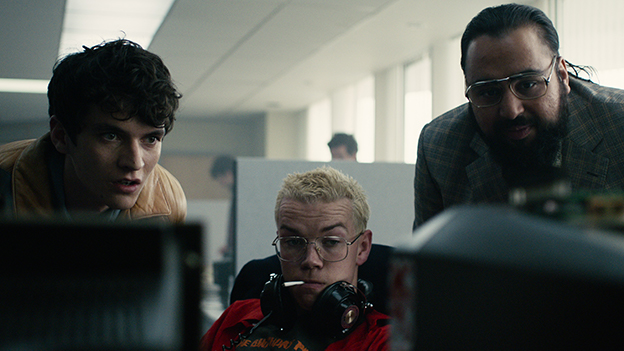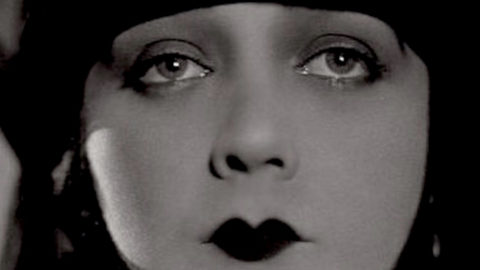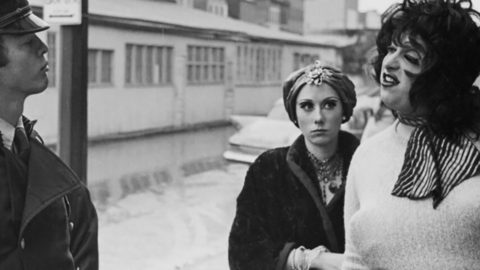Higher Learning: The Unwatchable
This article is part of Higher Learning, a new regular feature at Film Comment in which campus-based scholars share concise essays bringing our readers into the rich and varied conversations occurring in the fields of film and moving-image studies. The following essay on seeing is from the collection Unwatchable (published by Rutgers University Press), which poses the question: what does it mean to proclaim something “unwatchable,” whether disturbing, revolting, poor quality, tedious, or literally inaccessible?

Black Mirror: Bandersnatch (David Slade, 2018)
A dear friend of mine loves movies so much that the worst thing he can find to say about a film is that it is “watchable.” We know that when he says something like this, it really means that the movie is terrible, but nevertheless there is something in it, however minor, that deserves attention. The great film director John Waters, asked in an interview which films he cannot bear to watch, confessed that he simply loves to watch movies, and when he sees a bad one, he always finds something to enjoy, something as simple as the miraculous apparition of a lamp glowing in the corner of a room.
I find the question “what do you find unwatchable?” very difficult to answer. In fact, I am tempted to say that I cannot think of anything that I find unwatchable, except, increasingly, professional football with its unending parade of injuries. Still, I find myself making exceptions with no good reason except that it is a Big Game. As a scholar of something called “visual culture” or “visual studies,” moreover, I feel professionally obliged to study the unwatchable, the watchers, and their guardians.
But first, perhaps we should consider things that are invisible or unseeable, things that I am physically prevented from seeing. Clearly I cannot watch things that cannot be seen. If my TV is broken, I can’t watch it, though if I wanted to be perverse, I could sit for a while and watch the TV set itself. Since, as I write, my eyesight is failing and I am looking forward to a cataract operation, there is an increasing number of things in the world I cannot see. Road signs are becoming increasingly illegible. As they grow faint, however, my desire and need to watch for them only grows, and my wife spends more time telling me to watch where I am going when we drive into the city.
So seeing and watching are quite distinct activities, the passive and active poles of the scopic field. We see lots of things that we do not watch, or (more precisely) watch for. In fact, most of the things we watch for are things that we cannot see, things we are looking for, waiting for, trying to bring into focus. Should we say that the less we see, the more watchful we become? Is watching a form of trying to see? Of keeping your eye on the ball? Watching is attentive, focused seeing, but perhaps not the only kind. Beholding, staring, and gazing, for instance, seem to occupy some middle zone between seeing and watching. The beholder (especially of art) is usually portrayed as a kind of hybrid figure, cultivating a “wise passiveness” of looking, receptive but well trained. Staring is, of course, impolite. It is the shameful moment when someone is caught watching in a way that he or she shouldn’t, closely related to a voyeur who is caught in the act. And gazing is closely related to beholding, but perhaps even more passive: it is a kind of ruminative, contemplative, even bovine exercise of seeing, abstract and detached—a bit like John Waters’s finding of pleasure in even the worst movies.
So what does the “un-” add to or subtract from watching and the watchable? How does this negation of seeing work? The obvious starting point is to divide what should not be watched, because it is prohibited, forbidden, from what we cannot bear to watch because it is too painful or disturbing. But this distinction is frequently blurred in practice. The feeling that I cannot bear to watch something can, under the right social conditions, become a moral imperative that no one should watch it. If I cannot stand to see pornography, and “I know it when I see it,” the next step is to ban it for everyone else. Scenes of cruel violence and torture that are unbearable to some are prohibited from being seen by others. So “unwatchability” is frequently accompanied by an asterisk that divides those who can or must watch (e.g., grown-ups, police, and other professionals) from those who should not (e.g., children and vulnerable, sensitive souls). There is also the prohibition on merely watching something, particularly the suffering of others, while remaining detached and even taking pleasure in the spectacle. Why is there something deeply tasteless about a president of the United States visiting the spectacular flooding of a city, praising the size of the crowd that comes to meet him, and never bothering to meet a single victim? Why did George W. Bush’s flyover of the disaster of Hurricane Katrina prove so politically damaging? If one is going to watch, so goes the feeling, one should also be prepared to act. “I just like to watch” is almost always a morally ambiguous declaration, especially when it has to do with what someone else regards as the unwatchable.
Moral prohibitions on seeing and showing are everywhere: images of god are forbidden, not because we cannot see them, but because we should not. Therefore, when they are shown, there is a powerful urge to destroy the images themselves, sometimes right along with their beholders. Iconoclasm is the attempt to transform the morally or politically unwatchable into the literally unseeable, and to convert or disappear the watchers. When a pious Roman Catholic smeared paint over Chris Ofili’s famous The Holy Virgin Mary (aka “Madonna with Elephant Dung”) at the Brooklyn Museum some years ago, his intention was not to disfigure or erase the Madonna (whose image is not prohibited but celebrated) but to protect the Madonna from being seen in the wrong way, accompanied by the obscene material of shit. He was happy to venerate the Madonna as represented in visual images, but this particular image he found unbearable, unwatchable. His action had the predictable effect of making many more people come to the Brooklyn Museum just to see the defaced painting.
The best rendering I have seen of the dynamics of the unwatchable is the first episode of the British television series Black Mirror. In this episode, a popular British princess has been kidnapped and is threatened with death if the prime minister refuses to fuck a pig on live television. As popular sentiment trends toward the minister giving in to this demand, he is finally compelled to do it. The government urges viewers not to watch this obscene spectacle as a way of resisting terrorism. But of course the mandate has exactly the opposite effect, and pubs all across England are jammed with eager spectators who await the broadcast in a kind of festival atmosphere. When the telecast is finally shown, however, a strange alteration occurs in the faces of the spectators. It takes the disgusted PM over an hour to fulfill the demand by completing the sex act. As the show goes on, the faces in the audience begin to shift to appalled disgust and horror. People begin to look away. The princess is released unharmed on a bridge over the Thames, but no one notices because they are all jammed into the pubs. It turns out that the kidnapper was not a terrorist, but an artist who was staging the entire thing as a performance. He had already released the princess and hanged himself before the deadline he had given the PM. His performance is quickly declared by sophisticated critics to be the first great work of art of the twenty-first century.
The declaration of the unwatchable, then, can often have just the opposite of its intended effect. To be told you must not see or show something is arguably the greatest temptation to do both. Thankfully, Black Mirror does not show the sex act, focusing instead on the faces of the spectators. I think that may be the general lesson to be learned from the category of the unwatchable. There is nothing in the world that is metaphysically and absolutely unwatchable. Or at least I personally have not been able to come up with an example of something I find unwatchable, because the minute I think of something, I begin to imagine what seeing it would be like, and how I would manage the pain or the shame. What we need to keep watch over, clearly, is ourselves.
W.J.T. Mitchell is Gaylord Donnelley Distinguished Service Professor of English Language and Literature, Art History, and the College at the University of Chicago. Essay reprinted with permission from Rutgers University Press and the author. The collection Unwatchable is edited by Nicholas Baer, Maggie Hennefeld, Laura Horak, and Gunnar Iversen, and available now from Rutgers University Press and booksellers.





